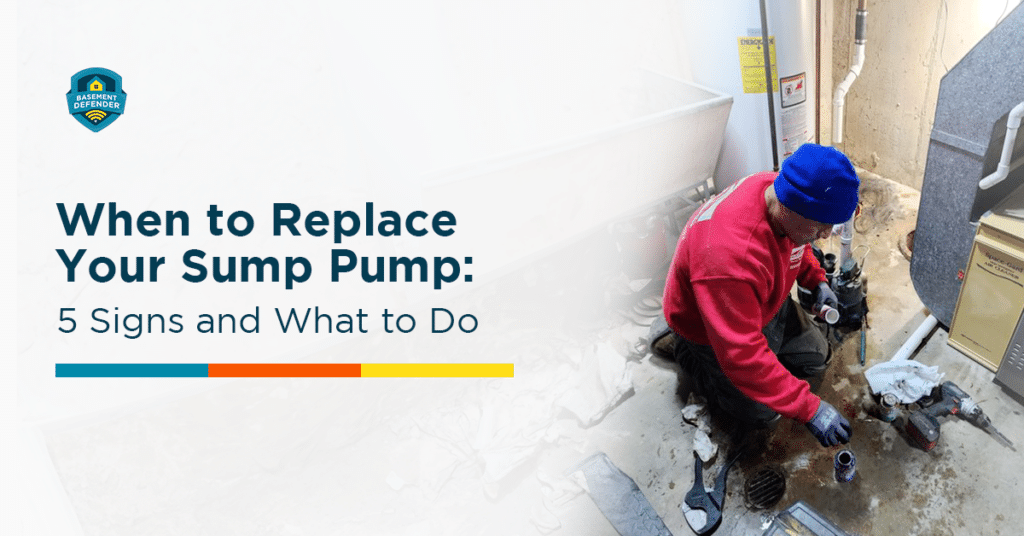
Basements have been an integral part of American homes for a long time. Unfortunately, moisture accumulation is a pressing concern. Recent data suggest that 98% of basements suffer from water damage, so it’s imperative to prioritize staying on top of this problem.
A sump pump system prevents water damage by moving accumulated water from your basement and crawl space to the outdoors. That said, knowing when to replace a sump pump is also essential to ensure efficient basement protection. Let’s explore the signs that indicate it’s time for a sump pump replacement.
Replacing your sump pump is a proactive way to prevent costly water damage from a system malfunction. You might ask—when should I replace my sump pump? Here are some telltale signs that it needs replacement ASAP.
How old is your setup? Typically, sump pumps have an average lifespan of 10 years from installation. However, it may break down sooner if it frequently operates non-stop for extended intervals.
Check the installation date, usually printed on the power cord or indicated by a “Replace by” sticker. If your pump is older than the recommended lifespan, immediate replacement is necessary to avoid potential malfunctions.
Unusual grinding, rattling, or humming sounds from your sump pump can signal internal debris or extensive component wear. Investigate the noise source and check the alignment, impeller, and lubrication for discrepancies. If you can’t identify any problems despite the noise, contact a sump pump technician for further assistance.
A pump running non-stop despite an empty sump pit or won’t start at all, even with accumulated water, may indicate a float switch issue.
This problem could also result from frequent power outages or faulty circuits damaging the sum pump’s hardware or reducing its electrical current. Fortunately, Basement Defender’s smart monitoring system sends alerts for low currents to help you stay informed.
Your basement must not have any signs of water damage with a working sump pump. If there are any, it may not be doing its job effectively, indicating the need for repairs or replacement. An underperforming pump has several possible causes, but a lack of a weep hole is usually a less considered one.
When the pump shuts off, it often draws air into the discharge pipe. Its airlock prevents the trapped air from escaping, causing burnouts and flooding. A weep hole drilled between the pump and check valve lets the air escape, improving the system’s efficiency.
Remember, your sump pump is part of your home’s electrical system, and power outages can damage it like any appliance. Whenever electricity returns after an interruption, there’s usually a sudden increase in voltage. This power surge may overload and fry your sump pump’s hardware. Unfortunately, you’ll have to replace the pump if it doesn’t start following a blackout.
While the average lifespan of a sump pump is a decade, the signs above indicate that you may have to do it sooner. As such, you can effectively secure your basement and crawl space against water damage before it happens.
You won’t have to worry about the sump pump replacement cost, as it’s significantly cheaper than a new installation. Here’s how you can replace your sump pump properly.
Before anything else, observe basic safety practices. Protect yourself from electric shock by disconnecting the pump from its power source.
Loosen the clamps securing the check valve in place. Doing so lets you remove the valve and detach the pump from the discharge pipe. Remove the sump pit’s lid and carefully lift the pump, ensuring you don’t damage any component.
It’s time to prepare the new pump. Use a hacksaw or pipe cutter to cut a new pipe to a similar length as the old one.
Secure the freshly cut pipe to the new pump. If it’s a threaded connection, you’ll have to use a threaded pipe and screw it in. If not, simply use PVC cement to secure the two components.
The pump should be level, upright, and sit under the pit’s lip. Also, ensure that the float switch can move freely and sits at an appropriate height to prevent early or delayed responses to floods.
Secure the check valve to the discharge pipe and the pump using hose clamps. You could also drill a weep hole between the check valve and the pump to prevent air bubbles from forming.
Additionally, if you have a backup pump on the same discharge line as the primary pump, you need the discharge check valve mounted below the backup pump, or the backup pump will not function properly.

Finally, connect the system to a power source, then perform a mock test. It ensures everything is in working order, so you can make adjustments accordingly if something fails.
Replacing your sump pump system is crucial for prolonging its lifespan and preventing potential malfunctions. By taking proactive steps to replace it before it fails, you can reduce the risk of moisture accumulation in your basement. With this, you can protect your home from floods, water damage, and subsequent safety and health risks.
Stay ahead of malfunctions and integrate Basement Defender’s monitoring system into the new pump. Our setup equips you with a sump pump monitoring app, enabling round-the-clock performance tracking to help you keep your home and loved ones safe.
Fill out our contact form for more information, and visit our shop to start securing your house!

Roy is a respected authority in the waterproofing industry, with over 40 years of experience under his belt. His company, Perma-Seal, has earned a reputation as Chicagoland’s premier waterproofing contractor, thanks to Roy’s unwavering commitment to quality, integrity, and customer satisfaction.
His latest innovation, the Basement Defender, is a testament to his dedication to providing homeowners with the best possible protection against basement flooding, representing a major leap forward in the industry’s efforts to prevent water damage and save homeowners from costly repairs.